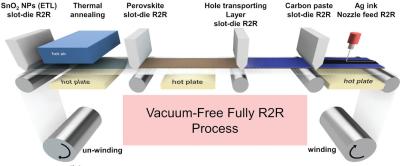Researchers from Monash University, University of Illinois at Chicago, University of Cambridge and CSIRO Manufacturing have used solution-processed, printable diodes based on perovskite thin films to make a printable, multi-energy X-Ray detector with significantly enhanced flexibility and sensitivity.
Schematic depiction of the fabrication process of an X-ray diode on flexible substrates using a custom-made slot die set up on a commercial R2R coater.
Silicon and selenium X-ray detectors are the most common for multi-energy X-ray detection. however, these tend to present poor energy discrimination across the broad X-ray spectrum and exhibit limited spatial resolution due to the high thicknesses required for radiation attenuation. In this recent work, the new technology for the X-ray detector is able to overcome these challenges.
By harnessing an optimized n-i-p diode configuration, operation is achieved across a broad range of soft and hard X-ray energies stemming from 0.1 to 10's of keV. Through detailed experimental and simulation work, it was shown that optimized Cs0.1FA0.9PbI3 perovskites effectively attenuate soft and hard X-rays, while also possessing excellent electrical properties to result in X-ray detectors with high sensitivity factors. Harnessing the solution-processable nature of the perovskites, roll-to-roll printable X-ray detectors on flexible substrates were also demonstrated.
"These perovskite-based detectors can provide rapid response times and offer high sensitivities to enable real-time detection and imaging for complex purposes, including disease diagnoses, detection of explosives, and identifying food contamination," Dr. Babar Shabbir, a senior Exciton Science Research Fellow and the first author of the paper, said in a statement.




